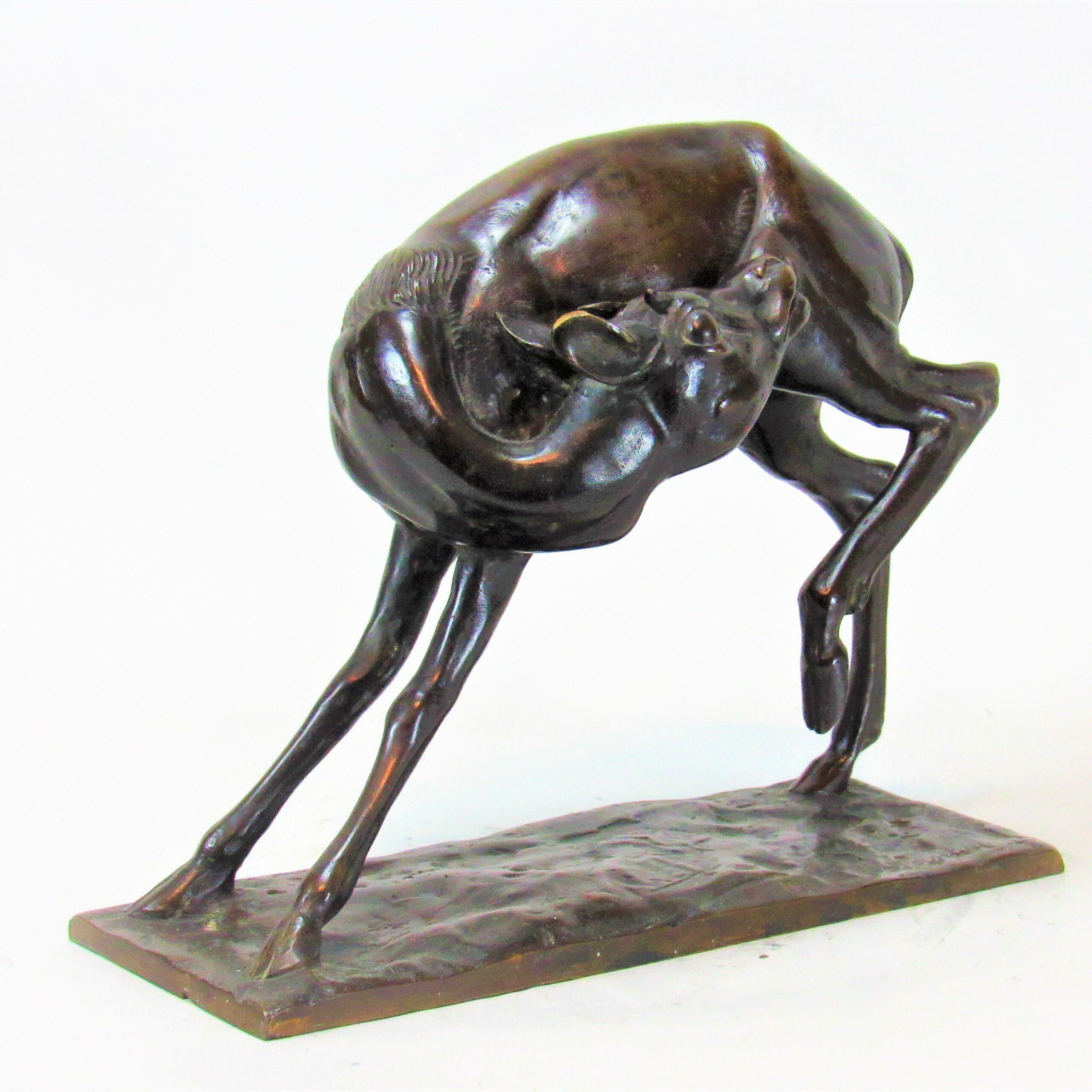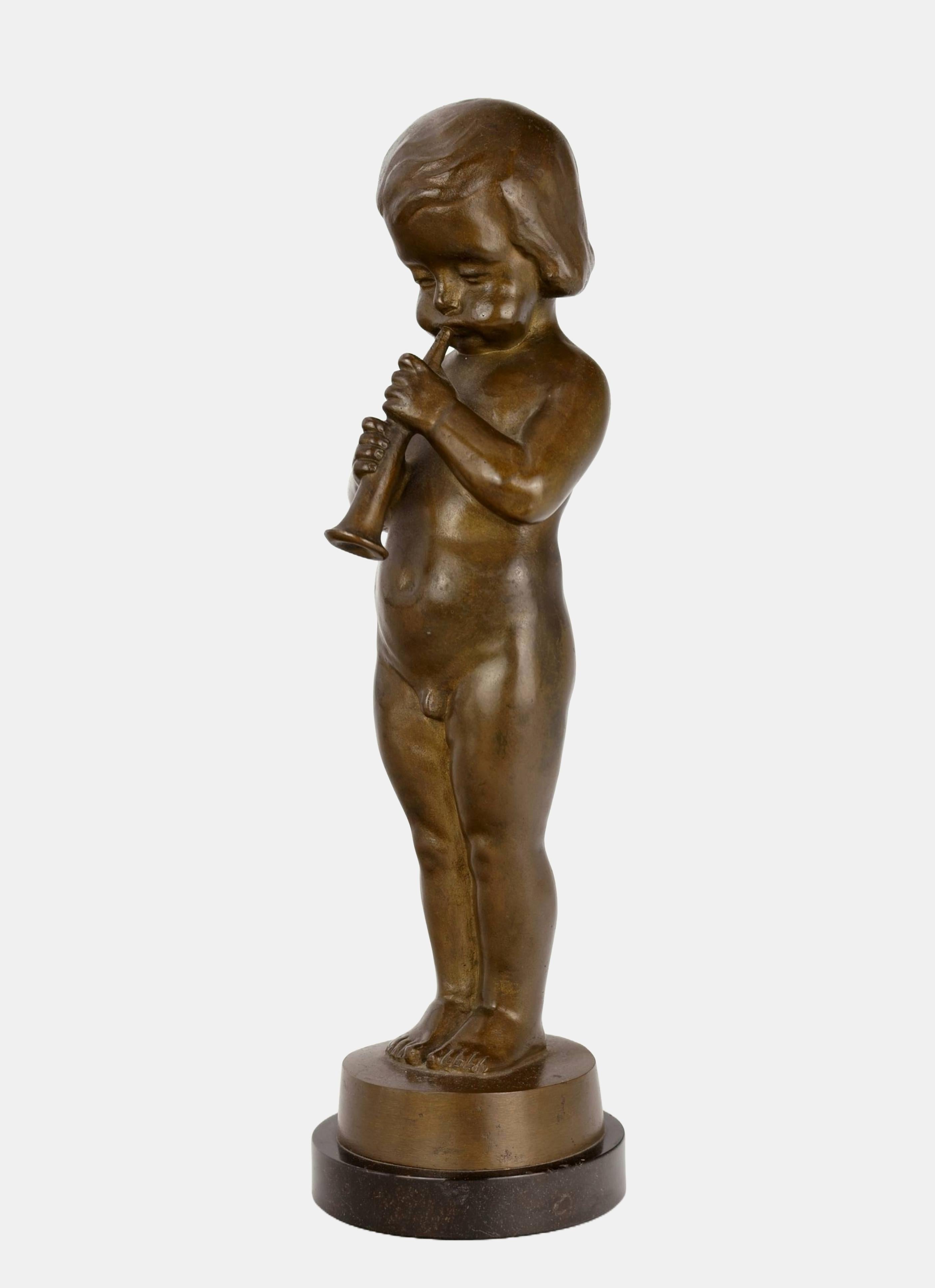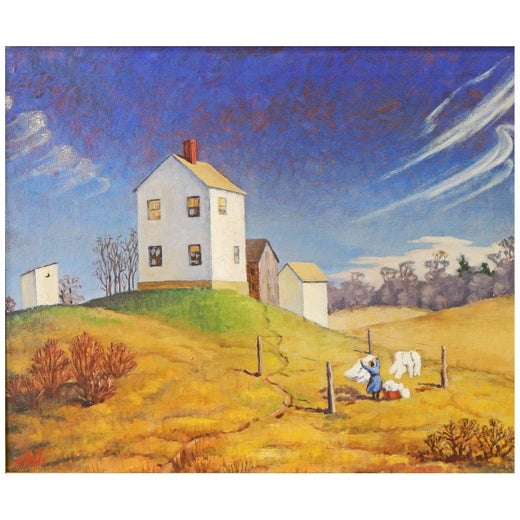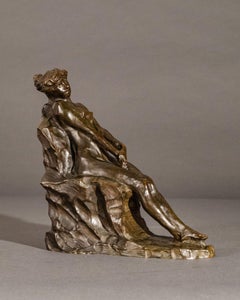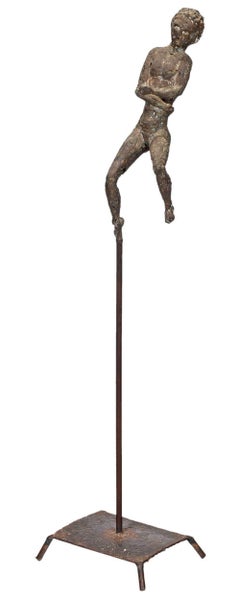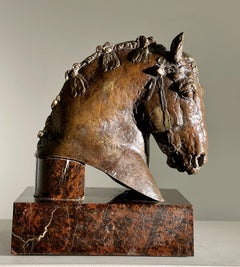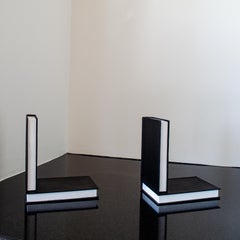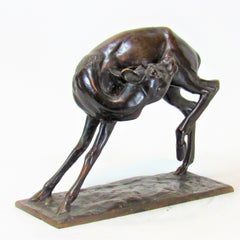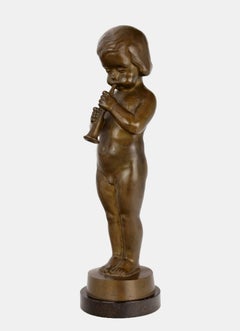Items Similar to "Untitled (Young Woman Nude) " Warren Wheelock, Art Deco, Modernist Female Form
Want more images or videos?
Request additional images or videos from the seller
1 of 8
Warren Wheelock"Untitled (Young Woman Nude) " Warren Wheelock, Art Deco, Modernist Female Form1924
1924
$12,000
£8,927.02
€10,466.24
CA$16,783.52
A$18,739.29
CHF 9,832.31
MX$231,276.02
NOK 123,593.38
SEK 115,643.52
DKK 78,079.93
Shipping
Retrieving quote...The 1stDibs Promise:
Authenticity Guarantee,
Money-Back Guarantee,
24-Hour Cancellation
About the Item
Warren Wheelock
Untitled (Young Woman Nude), 1924
Incised signature and date to edge of base "© 1924 by Warren Wheelock"
Bronze
Sculpture: 20 h × 4½ w × 4½ d inches
Base: 5¾ h × 5¾ w × 5¾ d inches
Overall: 25¾ h × 10¼ w × 10¼ d inches
Provenance
Private Collection, New York
Thence by descent
Exhibitions
Roslyn Harbor, New York, Nassau County Museum of Art, Deco at 100, January 18 - June 15, 2025.
Warren Wheelock, a self-taught artist, adopted a wide range of sculptural terminology, crafting conventional portraits of notable individuals alongside more abstract forms featuring sharp lines and smooth depressions. His sculptural work developed in part from a fascination with whittling, which involves sculpting a small piece of wood through careful, calculated knife cuts. He gained particular recognition for his pristine geometric forms to craft figures that were non-representational, and Wheelock also created heroic portraits. He worked with oil on wooden panels and plaster. He sculpted soapstone and created bas reliefs in plaster. In 1915, Wheelock constructed a log cabin in the mountains of North Carolina, which he utilized as his studio. He became a vibrant part of the community and took on roles as a teacher, doctor, and undertaker. Wheelock served in Company K of the 6th Massachusetts Volunteer Infantry Regiment during the Spanish-American War.
- Creator:Warren Wheelock (1880-1960, American)
- Creation Year:1924
- Dimensions:Height: 25.75 in (65.41 cm)Width: 10.25 in (26.04 cm)Depth: 10.25 in (26.04 cm)
- Medium:
- Movement & Style:
- Period:
- Condition:
- Gallery Location:New York, NY
- Reference Number:1stDibs: LU1841216543462
Warren Wheelock
Warren Wheelock is best known for his highly-recognizable, abstract sculptures in bronze and wood. He also painted on occasion, bringing the same clarity of vision and mastery of the medium to his art.
About the Seller
5.0
Platinum Seller
Premium sellers with a 4.7+ rating and 24-hour response times
Established in 2022
1stDibs seller since 2022
107 sales on 1stDibs
Typical response time: <1 hour
- ShippingRetrieving quote...Shipping from: New York, NY
- Return Policy
Authenticity Guarantee
In the unlikely event there’s an issue with an item’s authenticity, contact us within 1 year for a full refund. DetailsMoney-Back Guarantee
If your item is not as described, is damaged in transit, or does not arrive, contact us within 7 days for a full refund. Details24-Hour Cancellation
You have a 24-hour grace period in which to reconsider your purchase, with no questions asked.Vetted Professional Sellers
Our world-class sellers must adhere to strict standards for service and quality, maintaining the integrity of our listings.Price-Match Guarantee
If you find that a seller listed the same item for a lower price elsewhere, we’ll match it.Trusted Global Delivery
Our best-in-class carrier network provides specialized shipping options worldwide, including custom delivery.More From This Seller
View All"Reclining Woman" Karl Bitter, Reclining Woman with Reddish Patina
Located in New York, NY
Karl Bitter
Reclining Woman, 1897
Signed: Bitter 97
Stamped: GORHAM M F G CO.
Bronze
10.25 x 10.25 x 4 inches
Initially from Vienna, Karl Bitter first studied art at the city’s Kunstgewerbeschule and the Kunstakademie before being drafted into the Austrian army. He deserted his position in the military while on leave, and departed for New York City where he would discover considerable success. Early on, he won a competition for the Astor memorial bronze gates at Trinity Church, which awarded him enough capital to open his own studio. He went on to execute sculptures of Alexander Hamilton and Thomas Jefferson at the Cuyahoga Courthouse in Cleveland; he also created portraits of Jefferson for the state of Missouri and the University of Virginia. These commissions caught the attention of sculptor Richard Morris Hunt (who famously designed the façade of the Metropolitan Museum), earning Bitter the duty of producing the portrait medallions that now appear near the top of the museum’s grand face.
Notably, he presented at Chicago’s 1893 World’s Columbian Exposition and directed the Pan-American Exposition in Buffalo in 1901. Over his career, his artwork became more flexible – his early academy training is easily identifiable within his work, but after moving to America, conventions of Modernism became more prevalent within his sculpture. In addition to many awards, Bitter presided over the National Sculpture Society in 1906-1907, and was a member of the National Institute of Arts and Sciences, the National Academy of Design, the American Academy of Arts and Letters, the Architectural League, and the Art Commission, New York. His public work can be found at the Biltmore Estate, Asheville, NC; Gettysburg National Military Park, Gettysburg, PA; Wisconsin State Capitol, Madison, WI; United States Naval Academy...
Category
1890s Realist Figurative Sculptures
Materials
Bronze
"Dancer" David Hare, Male Nude, Figurative Sculpture, Mid-Century Surrealist
By David Hare
Located in New York, NY
David Hare
Dancer, circa 1955
Bronze with integral stand
68 high x 17 wide x 13 1/2 deep inches
“Freedom is what we want,” David Hare boldly stated in 1965, but then he added the caveat, “and what we are most afraid of.” No one could accuse David Hare of possessing such fear. Blithely unconcerned with the critics’ judgments, Hare flitted through most of the major art developments of the mid-twentieth century in the United States. He changed mediums several times; just when his fame as a sculptor had reached its apogee about 1960, he switched over to painting. Yet he remained attached to surrealism long after it had fallen out of official favor. “I can’t change what I do in order to fit what would make me popular,” he said. “Not because of moral reasons, but just because I can’t do it; I’m not interested in it.”
Hare was born in New York City in 1917; his family was both wealthy and familiar with the world of modern art. Meredith (1870-1932), his father, was a prominent corporate attorney. His mother, Elizabeth Sage Goodwin (1878-1948) was an art collector, a financial backer of the 1913 Armory Show, and a friend of artists such as Constantin Brancusi, Walt Kuhn, and Marcel Duchamp.
In the 1920s, the entire family moved to Santa Fe, New Mexico and later to Colorado Springs, in the hope that the change in altitude and climate would help to heal Meredith’s tuberculosis. In Colorado Springs, Elizabeth founded the Fountain Valley School where David attended high school after his father died in 1932. In the western United States, Hare developed a fascination for kachina dolls and other aspects of Native American culture that would become a recurring source of inspiration in his career.
After high school, Hare briefly attended Bard College (1936-37) in Annandale-on-Hudson. At a loss as to what to do next, he parlayed his mother’s contacts into opening a commercial photography studio and began dabbling in color photography, still a rarity at the time [Kodachrome was introduced in 1935]. At age 22, Hare had his first solo exhibition at Walker Gallery in New York City; his 30 color photographs included one of President Franklin Roosevelt.
As a photographer, Hare experimented with an automatist technique called “heatage” (or “melted negatives”) in which he heated the negative in order to distort the image. Hare described them as “antagonisms of matter.” The final products were usually abstractions tending towards surrealism and similar to processes used by Man Ray, Raoul Ubac, and Wolfgang Paalen.
In 1940, Hare moved to Roxbury, CT, where he fraternized with neighboring artists such as Alexander Calder and Arshile Gorky, as well as Yves Tanguy who was married to Hare’s cousin Kay Sage, and the art dealer Julian Levy. The same year, Hare received a commission from the American Museum of Natural History to document the Pueblo Indians. He traveled to Santa Fe and, for several months, he took portrait photographs of members of the Hopi, Navajo, and Zuni tribes that were published in book form in 1941.
World War II turned Hare’s life upside down. He became a conduit in the exchange of artistic and intellectual ideas between U.S. artists and the surrealist émigrés fleeing Europe. In 1942, Hare befriended Andre Breton, the principal theorist of surrealism. When Breton wanted to publish a magazine to promote the movement in the United States, he could not serve as an editor because he was a foreign national. Instead, Breton selected Hare to edit the journal, entitled VVV [shorth for “Victory, Victory, Victory”], which ran for four issues (the second and third issues were printed as a single volume) from June 1942 to February 1944. Each edition of VVV focused on “poetry, plastic arts, anthropology, sociology, (and) psychology,” and was extensively illustrated by surrealist artists including Giorgio de Chirico, Roberto Matta, and Yves Tanguy; Max Ernst and Marcel Duchamp served as editorial advisors.
At the suggestion of Jacqueline Lamba...
Category
1950s Abstract Figurative Sculptures
Materials
Bronze
$20,000 Sale Price
20% Off
"Sudbourne Premier: Suffolk Punch Stallion" Herbert Haseltine, 1927 Bronze
Located in New York, NY
Herbert Haseltine
Sudbourne Premier: Suffolk Punch Stallion, 1927
Signed left side: © HASELTINE / MCMXXVII
Bronze, dark brown patina, parcel gilding
...
Category
1920s Realist Figurative Sculptures
Materials
Bronze
"Untitled (Bookends)" Steven Wolfe, Illusionistic Book Sculpture, Trompe-l'oeil
Located in New York, NY
Steven Wolfe
Untitled (Bookends), 1990
Stamped: SW 1990 2/3
Painted Bronze
6 1/4 x 7 x 4 inches
Edition 2/3
Steven Wolfe crafted sculptures and drawings of remarkable skill and vis...
Category
1990s Contemporary Figurative Sculptures
Materials
Bronze
"Jules Bastien LePage" Augustus Saint-Gaudens, Bas Relief of French Painter
By Augustus Saint-Gaudens
Located in New York, NY
Augustus Saint-Gaudens
Jules Bastien LePage
Bronze
14 1/4 x 10 1/8 inches
Augustus Saint-Gaudens was born in 1848 in Dublin, Ireland. His father, Bern...
Category
1880s Realist Figurative Sculptures
Materials
Bronze
"Poodles: Nora and Sheila" Herbert Haseltine, 1944 Bronze Animalier Sculpture
Located in New York, NY
Herbert Haseltine
Poodles: Nora and Sheila, 1944, cast 1945
Signed and dated on base
Bronze with green patina
11 inches high x 17 inches wide x 6 inc...
Category
1940s Realist Figurative Sculptures
Materials
Bronze
You May Also Like
Italian animal bronze: Young Deer or Antelope by Sirio Tofanari
Located in Gent, VOV
Young Antelope Or Young Deer
A nice bronze cast of a young antelope or a young male deer licking its back, by Sirio Tofanari (1886-1969). An old cast wi...
Category
1930s Art Deco Figurative Sculptures
Materials
Bronze
Bacchante
By Charles Despiau
Located in PARIS, FR
Bacchante
by Charles DESPIAU (1874-1946)
Sculpture in bronze with nuanced dark brown patina
Signed at the back "C. Despiau"
Cast by Alexis RUDIER
France
Vers 1930
Height 23 cm
Width 18 cm
Depth 13 cm
The plaster model of "Bacchante" was exhibited in 1909 at the Salon of the Société Nationale des Beaux-Arts.
Charles Despiau produced several variants of this work, including the one presented here.
Among other known versions, there is one cast with the right leg cut off, four casts with the torso alone and eight casts with the raised leg (1929).
Bibliography :
"Charles Albert Despiau", Collections du musée...
Category
1930s Art Deco Nude Sculptures
Materials
Bronze
Young girl sitting at her toilet
By Joseph Bernard
Located in PARIS, FR
"Young girl sitting at her toilet"
also known as "Young girl with braids"
by Joseph BERNARD (1866-1931)
Sculpture in bronze with a nuanced brownish dark green patina
Signed on the ...
Category
1920s Art Deco Nude Sculptures
Materials
Bronze
Boy playing the shawm / - The transience of sounds -
Located in Berlin, DE
Hans Harders (1875 Mörel - 1955 Berlin), Boy playing the shawm, around 1930. Dark patinated bronze with round plinth on a black marble base (2 cm high), t...
Category
1930s Art Deco Nude Sculptures
Materials
Bronze
$2,099 Sale Price
20% Off
Naked warrior with short sword / - The New Hercules -
Located in Berlin, DE
Hermann Volz (1847 Karlsruhe - 1914 ibid.), Naked warrior with short sword, c. 1935. Partially (?) patinated bronze with cast plinth mounted on a black marble base (6.8 cm high). 32....
Category
1930s Art Deco Nude Sculptures
Materials
Bronze
Gladiator ready for battle / - Ready for anything -
By Bruno Zach
Located in Berlin, DE
Bruno Zach (1891 Zhitomir - 1945 Vienna), Gladiator ready for battle, c. 1930. Blackish patinated bronze with silver-plated helmet, shield rim and shield pommel mounted on a fluted m...
Category
1930s Art Deco Nude Sculptures
Materials
Bronze
